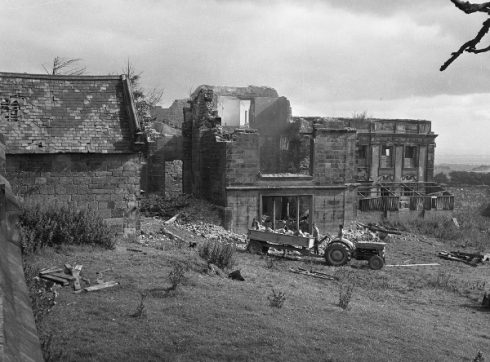
The demolition of John Griffith’s 1624 house at Brymbo. (Copyright NWN Media; used under their licence; downloading or commercial reproduction prohibited).
Many of the gentry houses of Britain failed to survive the 20th century. Even the old mansions of Wales, often very different buildings to those attached to the large estates of England, proved in many cases to be just too impractical or expensive to maintain.
Brymbo’s own large house, the former home of the Griffith family and the centre of the small but historically significant estate later purchased by the ironmaster John Wilkinson, was no exception to this. The remarkable picture above shows its sad end, though this was only after a long period of decline and dereliction.
By the end of the 19th century the Hall was one of the more unusual assets of the Brymbo steel company, the successor to Wilkinson’s business empire. Although much of the old estate was given over to industry, the demesne land of the Hall – “Brymbo Park” as locals called it – and its sheltering wood were still, more or less, intact.
In this era the house itself was occupied by Peter Williams, the talented steelworks employee who had risen to the position of General Manager (and finally to Managing Director). It was Williams who, under John Henry Darby, had employed the open-hearth steelmaking process in 1883-84, a first in Britain. However, the antiquated house fell out of use in the first part of the 20th century and by the 1920s it was empty, save for the occasional presence of a caretaker.
During the 20s it was suggested that the Hall was turned into a village institute for Brymbo. The idea was seriously explored and some plans were drawn up, but sadly it all came to nothing: if it had succeeded, this would surely have been the most spectacular and architecturally significant village institute in the country. Instead, the building became increasingly derelict, and began to gain a sinister reputation locally, as large abandoned buildings often do.
The Hall was briefly used in the Second World War. By the 1940s the land behind it was opencast: after all those centuries of being preserved from the intense mining activity that went on around it, the house and its surrounding land sat on a huge pillar of coal. Finally the occupant of the estate’s old home farm decided to put the house to some use, and chickens and pigs lived in the rooms that John Wilkinson had once known. The eastern wing lost its old roof, and many of the windows were bricked up, while the terraced gardens dwindled to grass and weeds.
However, it was the coal that had once made the estate so valuable that was to prove the old house’s final undoing. It just outlasted the township’s other main building, Plas Mostyn, also dating from the early 17th century. It is stated in many books that the Hall was demolished in 1973, shortly before the “Ty Cerrig Extension”, as the second phase of the large opencast works immediately south of Brymbo village was formally known, was opened up. However, the first set of opencast workings, covering some 81 acres north of the road to Penrhos, was commenced in 1971, and the date of the picture at the beginning of this article seems to suggest that demolition of the Hall may have started, at least, in 1970.
With it went a huge chunk of the area’s history – not just the house itself, with its memories of Wilkinson and its many earlier owners, but no doubt all kinds of archaeological evidence of a site used for hundreds of years. By the mid 1970s, as the picture at right shows, a huge pit occupied the site of the Hall and the Park. A survey by the Clwyd-Powys Archaeological Trust, conducted around 1978, found nothing left.

No comments:
Post a Comment